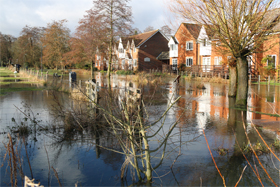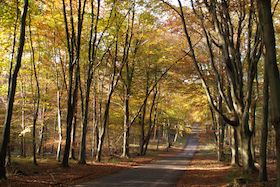These comments are based on the geographical position of Marlborough in the UK and therefore not applicable to any other part the country.
January

The first month of the year is the coldest month with a mean temperature of 4.0C. However, exceptionally warm days have occurred as in January 2015 when the thermometer rose to 14.2C. The year 1987 brought severe weather with a mean for the month of -0.15C, which is a considerable 4C below the long-term average. Therefore it is not surprising to find that snow fell on four days. The position of the UK in a temperate latitude means that this month can bring a mix of contrasting weather types. There are often hard air frosts with an average of 11 a month although in 1985 and 2012 the severe winter months brought 22 nights with an air frost. As in most months rainfall varies considerably but the mean is 92.6mm. The extremes were in 1997 with 9.4mm and 2014, a very wet month, with 219.1mm.
January data: Actual temperatures | Mean temperatures | Rainfall
February

This is the coldest month of the year as any residual warmth in the ground remaining from the autumn has now evaporated and the sun is very low, with little strength. During the nights the ground radiates heat energy into space so in clear nights the thermometer can drop consistently and quickly called radiation nights. Although the mean temperature is 4.1C, the mean minimum is 1.0C, which is 0.3C colder than January. The average number of air frosts is similar at 11 per month. The record low temperature of -13.8C was set on 11th February 2012. A severe month occurred in 1986 when the mean temperature was -2.0C, which is 6C below the long-term mean. There were only two nights that month without an air frost, some of which went as low as -10C and -11C. February is a drier month than January with a mean rainfall total of 65.5mm with totals ranging from 9.9mm in 1986 and 151.6mm in 2014.
The average rainfall of 65mm has varied very little over the past twelve years.
February data: Actual temperatures | Mean temperatures | Rainfall
March

The sun reaches its vernal equinox this month so its strength is increasing. This occurs on our about 21st March but it varies in the northern hemisphere between 20th and 22nd March depending on our position in the leap year cycle. With a mean temperature of 6.3C it is 2C warmer than March so there are fewer air frosts, averaging 9 per month. The day temperature can rise quite high in any lengthy warm spell with the record of 21.0C set in 2012, although the thermometer can drop to –-7C or -8C in any very cold spell. The year 2013 stands out as the coldest over the past 32 years, by several degrees, with a mean of 2.7C compared to the average of 6.3C. Significant plant growth can begin in a warmer March as this only takes place when the temperature is above 6C. As in all months the rainfall can range from very dry as in 2011 with 12.7mm or as occurred in 2001 when 113.7mm was recorded. The mean rainfall over the last 32 years is now 57.7mm.
March data: Actual temperatures | Mean temperatures | Rainfall
April

April is famous for its showers but it is rarely a dry month. In 1984, an exceptionally dry month, the total rainfall was just 2.0mm whereas in 2000 the precipitation was considerable setting a record at 165.2mm. April sees a significant rise in the mean temperature by 4.3C to 8.6C, when maxima can reach as high as 27.2C set in 2011. This is the month when significant plant growth begins although air frosts are a danger to tender plants. The average number of air frosts has now decreased to 5 with the record low temperature set in 1990 with -6.9C. The lengthening days can now produce 12 or 13 hours of strong sunshine. There has been an upward trend in the average mean temperature over the past twenty-five years by around 1C. The rainfall for April can fluctuate widely. In 1984 I recorded just 2mm but in contrast the year 2000 produced 165mm. Since that year there has only been one occasion with extreme rainfall, which occurred in 2012 with 146mm when the mean is 60mm.
April data: Actual temperatures | Mean temperatures | Rainfall
May

The last month in spring now sees a leap of over 3C in the mean temperature, to 11.83C, with the sun getting stronger and the length of daylight increasing considerably. Almost 15 hours of strong sunshine was recorded on 4th May 2016. However, the weather in May can be capricious when vigorous Atlantic depressions move in from the west, bringing cloud, wind and precipitation. Over the past 33 years the mean maximum temperature in Marlborough has varied from as low as 14.2C in 1996 to a very warm year in 1989 when 20.2C was recorded. The hottest day in May was in in 2010 when the thermometer peaked at 28.6C. Frosts have been known to occur in early May but usually only one or two. Winds from an easterly or northeasterly direction are not uncommon in this month and can set in for many days or dominate the month. These usually bring drier air but with lower temperatures. The mean rainfall this month is 60mm but dependent on the predominant wind direction, can vary from as little 6.7mm as occurred in 1990 to a very wet May in 2007 with 149.5mm.
May data: Actual temperatures | Mean temperatures | Rainfall
June

We expect the first month of summer to bring us summer weather, but this hope is often not realised. Being a small island surrounded by large tracts of water, if the wind comes from a westerly direction the warmer air at this time of the year will have absorbed large quantities of moisture and drop it over the country in varying amounts as in 1998 with 143mm and in 2012 with 128mm when the mean is 55mm. Thunderstorms can occur when southerly winds bring hot, humid air from the continent and unleash severe storms that bring torrential rain and hail accompanied by strong winds. The area around Marlborough often seems to miss these storms as many times I have witnessed them travelling in a northerly direction to the west and the east of this region. But with the sun at its peak late in the month we can experience scorching heat for several days as in 2006, which had twenty-one days well above the mean maximum of 20C and 30C the highest that year. The record was set in 1995 with 31.6C. Conversely, the start of June 1991 produced a sharp air frost, down to -1.6C, a record for June. The late 1980s early 1990s were decidedly chilly but since that time the mean has risen over 0.5C.
June data: Actual temperatures | Mean temperatures | Rainfall
July

This is the month with the highest mean temperature, 16.9C, as the sun is only just passing its zenith and the ground has accumulated warmth over the previous months. As a rule, the summers at this latitude are not usually uncomfortable due to our position in the temperate latitude with areas of sea surrounding our island that moderate hot air if it comes on a hot dry easterly from central Asia. The mean maximum has varied considerably between a very hot July in 2006 that produced a mean of 26.8C, compared with 19.0C in 1988. The very hot and dry July in 2006 gave us twenty dry days, a peak temperature of 35.9C with minima rainfall of 10mm. This is another month when thunderstorms can break out as hot, humid air moves north from the continent as in July 2002 when 41mm of precipitation was recorded on one day.
July data: Actual temperatures | Mean temperatures | Rainfall
August

This is the last of the summer months as we enjoy many fewer hours of sunlight that is also waning in strength. The first hints of autumn can often be seen towards the end of the month although the mean temperature is only 0.4C below that of July as the ground still holds onto much of the summer warmth. Any thunderstorms that form can be prolonged and frequent as in August 2010 with 41.7mm in one day. The air is still very warm and thus holds large quantities of moisture that on rising air currents can form into sizeable raindrops and large hail if carried far enough into the atmosphere. But, as in other summer months rainfall can vary enormously such as 5.3mm in 1995 to the record wet August in 1992 with 140mm. Heat waves do occur as in August 1990 that opened with intense heat for fourteen days with the thermometer soaring to the high 20s and low 30s on the first four days with a maximum of 35.2C on the 3rd. There has been a general cooling over the past ten years following the exceptional years of 1995 and 1997.
August data: Actual temperatures | Mean temperatures | Rainfall
September

September is a transition month when prolonged warm spells can occur or early autumn can arrive on Atlantic westerlies accompanied by heavy rainfall. These two extremes have occurred within the past ten years with a very dry 11mm in 2009 and 132mm in 2006. However, the frequency of below average rainfall is greater than the very wet months. The average rainfall has decreased over the past fifteen years by almost 8mm. Another factor that is more likely to occur is the increase in wind speeds, sometimes associated with the remnants of former hurricanes having travelled over the Atlantic. Due to the possibility of very different weather systems it is not surprising that the temperature range can also vary widely. For example in 1986 the mean was a very cool 10.C but twenty years later the mean was 16.8C. There was a noticeable warming trend between 1993 and 2006 when the average temperature increased by 1.8C and has been at or around that figure for the past ten years.
September data: Actual temperatures | Mean temperatures | Rainfall
October

October is the first real autumnal month with the mean over 3C cooler than September and a pivotal month meteorologically. The autumnal equinox , when daylight hours equal the hours of darkness, occurs between 20th and 22nd of October depending on our position in the leap year cycle. The hours of daylight, as with the strength of the sun, are much diminished. However, strong sunshine hours can reach into double figures as at the beginning of October 2015. At the beginning of October 2011 a maximum of 26.7C was recorded, so more like summer than autumn. This followed the very warm dry period of a week that started at the end of September, with maxima up to 27C. This might be called an ‘Indian Summer’, an expression that almost certainly owes its origin to North America than India. The North American Indians relied on extended dry, warm spells to harvest their crops before the long snowy winter set in. The mean temperature is now almost 4C below that of September. The rainfall average is 25mm greater than that for September and on eleven occasions in the past 32 years the daily rainfall total has surpassed 100mm.
October data: Actual temperatures | Mean temperatures | Rainfall
November

November is often recalled in the poem by Thomas Hood that starts with “No sun, no moon, no morn, no noon. No dawn, no dusk, no proper time of day”. Any lingering autumn colours will be a bonus when any week sunlight illuminates them but most will have disappeared as the month progresses. Although the sun is low in the sky strong sunshine can total five or six hours but the days without strong sunshine can amount to nearly half the month. Although the season of winter arrives next month, there can be very cold spells, such as 1985, one of the coldest Novembers in the last half-century, with a mean temperature of 3.7C, which is 3C below the average. By way of contrast a very warm November can be enjoyed such as occurred in 1994 with a mean of 10C. Due to the lower temperatures and increased humidity fog usually occurs on a few days. Very rarely does snow fall as happened on one day in 1988 and again in 2015. Rainfall totals can vary widely from as little 28mm in 1990 to the extremely wet November in 2002 when on nine days the daily total was in double figures and 204mm was measured for the whole month. As the land masses surrounding the UK rapidly cool down, the oceans retain their warmth longer thus the increasing temperature contrast that fuels Atlantic storms.
November data: Actual temperatures | Mean temperatures | Rainfall
December

December is the month with minimal daylight hours as we approach the shortest day of the year on or around 21st December, depending on the leap year, when the sun is above the horizon for less than eight hours. The sun is also very low in the sky and thus weak but strong sunshine can, on the odd day, total five hours. However, there are dreary Decembers, such as was recorded in 2015, when on nineteen days no strong sunshine occurred. The land mass is still cooling down but not at its lowest being 2C below the November mean. The mean maximum is 7C but when longer periods of weak sunshine occur the thermometer can reach into double figures or even higher as on two days in 2015 with a maximum if 14.3C, equivalent to an October day. As with most months the rainfall totals can vary widely but December can be the wettest of the year as occurred in 2012 and 2013, with 155mm and 157mm respectively, but is usually two or three months lower down the order. As this month progresses the forecasters are harassed by questions about a white Christmas, that rarely occurs, however, in December 1990 havoc was caused on the roads as snow fell on two days, the 8th and 9th, a most unusual occurrence. Snow also fell on the 17th that month.
December data: Actual temperatures | Mean temperatures | Rainfall

